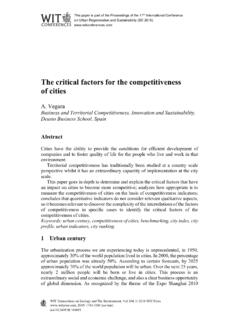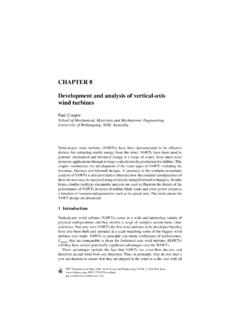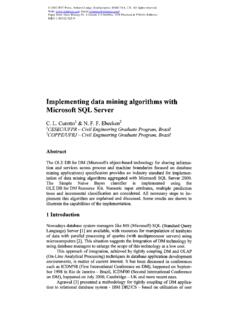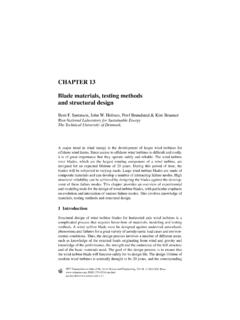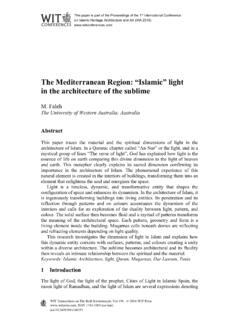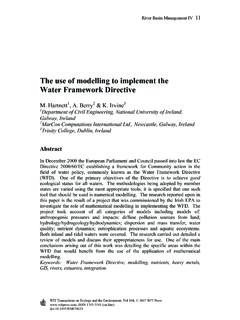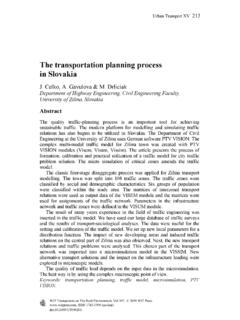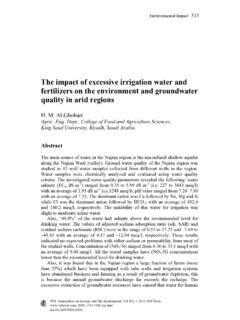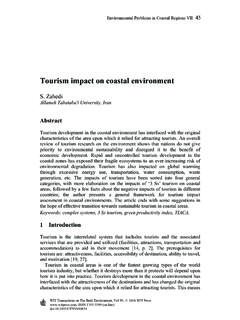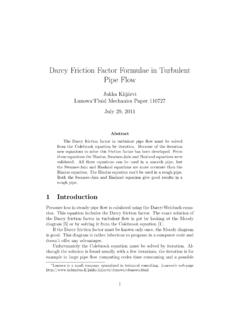Transcription of Four explicit formulae for friction factor calculations in ...
1 Four explicit formulae for friction factor calculations in pipe flow V. E. M. G. Diniz1 & P. A. Souza2 1 Hydraylic Engineering Consultant, Brazil 2 Department of Hydraulic and Sanitary Engineering of Polytechnic School, S o Paulo University, Brazil Abstract This paper presents four explicit formulae to calculate the friction factor for all flow regimes present at Moody diagram without iterations, including the critical zone, for four different problems. The first formula is used to calculate the head losses of pipes given its discharges, lengths, diameters, absolute roughness, the kinematic viscosity of the fluid that flows in the pipes and the gravity acceleration. The second formula is used to calculate the discharges of pipes given its head losses, lengths, diameters, absolute roughness, the kinematic viscosity of the fluid that flows in the pipes and the gravity acceleration.
2 The third formula is used to calculate the diameters of pipes given its discharges, lengths, head losses, absolute roughness, the kinematic viscosity of the fluid that flows in the pipes and the gravity acceleration. The fourth formula is used to calculate the diameters of pipes given its lengths, head losses, absolute roughness, the kinematic viscosity of the fluid that flows in the pipes, the fluid velocities in the pipes and the gravity acceleration. The calculated friction factors are used to calculate the discharges, head losses and diameters of pipes for the steady state and for the extended period state. A case study is presented where it was possible to apply the first two formulae to calculate the friction factors for the steady state in a water main with nine pipes. The results show that the two applied formulae are working well because the calculated pressure heads of some nodes of the water main were compared to the pressure heads gauged in situ on the same nodes of the water main and the results were close.
3 Keywords: friction factor calculation , explicit formulae , Moody diagram, four different problems, steady state, case study. Water Resources Management V 369 , ISSN 1743-3541 (on-line) 2009 WIT PressWIT Transactions on Ecology and the Environment, Vol 125, Introduction When a fluid flows from one point to another inside a pipe, there will always be a head loss (liquid or gas). This head loss is caused by the friction of the fluid with the inner surface of the pipe wall and by turbulences of the fluid flow. So, the greater the roughness of the pipe wall or the more viscous the fluid, the greater the head loss. In order to establish laws that may govern the head losses in conduits, research and studies have been carried out for around two centuries. Currently the most precise and universally used expression for analysis of flow in pipes, which was proposed in 1845, is the well-known Darcy Weisbach equation.
4 Nevertheless, a safe way to determine the friction factor (f) was not found early. The determination of the friction factor is a difficult problem to solve; for the steady state as for the transient state. Only in 1939, almost 100 years later, a law was definitely established to determine the friction factor for the permanent regime, through the Colebrook White equation [1]. The modeling of the friction factor in a transient flow is generally accomplished either considering it equal to the friction factor for the steady state that occurs at each time step, or considering it constant and equal to the friction factor for the initial steady state, but it is not taken into account that during the transient flow, the velocity profile changes at every time step, even occurring the reverse flow. During a transient it is possible to occur a velocity profile that generates no discharge with a shear stress different from zero on the pipe wall.
5 The use of a constant friction factor can lead to an error of prediction in the study of the phenomenon of liquid column separation during the passage of reflected waves (Lima [2]). The Colebrook White equation has been considered as the most precise law of resistance to flow and it has been used as a referential standard, but in spite of this and the whole theoretical fundamentalism and base associated to it, it has a feature which is inconvenient to some people: It is implicit in relation to the friction factor , that is, the unknown f is present on both sides of the equation, without the possibility of being isolated from the other quantities presented in the equation. Its resolution requires an iterative process. It has given rise to many researchers, almost all over the world, to strive themselves in finding explicit equations, which could be used as alternatives to the Colebrook White equation, to calculate the friction factor .
6 Some more compact and simple, easier to be memorized, but with large deviations, others less compact and complex, more difficult to be memorized, but with minor deviations and some others matching simplicity and accuracy, with errors well reduced, in relation to the friction factor calculated with the Colebrook White equation [1]. This paper presents four explicit formulae to calculate the friction factor for four different problems. These formulae calculate the friction factors for all flow regimes present at Moody diagram without iterations, including the critical zone, where the Reynolds number (Re) varies from 2500 to 4000. 370 Water Resources Management V , ISSN 1743-3541 (on-line) 2009 WIT PressWIT Transactions on Ecology and the Environment, Vol 125,2 Literature review Kamand [3] presented mathematical and graphical methods to relate the friction factors of three widely used pipe friction equations and to determine the magnitude of the differences in calculated head losses.
7 friction factors were developed to be used with the Hazen Williams and the Manning equations for PVC and cast-iron pipes that give similar calculated head losses to those of the Darcy Weisbach equation. The friction factors developed should provide satisfactory results unless other values based on actual field or lab measurements or on practical experience are available. Von Bernuth and Wilson [4] collected friction loss data for three small diameter plastic pipe sections. Data analysis confirmed that the Blasius equation is a very accurate predictor of the friction factor when Reynolds numbers are less than 105. A combination of the Blasius and Colebrook-White equations was proposed as a convenient and accurate head loss prediction equation. The combination equation is dimensionally homogeneous, correctable for viscosity changes and accurate for small diameter plastic pipe as it is normally used.
8 It is conveniently written in flow rate, pipe diameter and pipe length terms. Sonnad and Goudar [5] analyzed the general applicability of a recent explicit expression of the Colebrook White equation for turbulent flow friction factor calculation . This explicit expression, which is based on the Lambert W function, contains an exponential term which imposes restrictions on its use. These constraints were expressed in terms of the pipe roughness and fluid Reynolds number for both single and double precision calculations , respectively. A mathematical relationship between the Reynolds number and the pipe roughness at this limiting condition was also presented. Before computing friction factors using the explicit Colebrook White equation, a quick check must be performed to see if the desired combination of pipe roughness and fluid Reynolds number values satisfies the applicable constraint mentioned above.
9 McKeon, Zagarola and Smits [6] examined power laws, classical logarithmic and generalized logarithmic friction factor relationships using high-Reynolds-number pipe-flow data in the range 31 103 Re 35 106. The constants of Prandtl s universal friction factor relationship were shown to be accurate over only a limited Reynolds-number range and unsuitable for extrapolation to high Reynolds numbers. New constants, based on a logarithmic overlap in the mean velocity, were found to represent the high-Reynolds-number data to within , and yield a value for the von K rm n constant that is consistent with the mean velocity profiles themselves. The use of a generalized logarithmic law in the mean velocity was also examined. A general friction factor relationship was proposed that predicts all the data to within and agrees with the Blasius relationship for low Reynolds numbers to within Yoo and Singh [7] proposed two methods for the computation of friction factors of commercial pipes in an explicit way.
10 The first method computes the mean zero velocity point (MZVP) and the other directly computes the mean friction factor (MFF). The MFF method is preferred because it covers all flow ranges, including laminar flow. Both MFF and MZVP methods consider two Water Resources Management V 371 , ISSN 1743-3541 (on-line) 2009 WIT PressWIT Transactions on Ecology and the Environment, Vol 125,parts of a wall with different roughness heights: One part is rough and the other is smooth. The materials of the pipes tested were galvanized iron, wrought iron, cast iron, concrete, riveted steel, and PVC. The analysis showed that both the roughness height and the relative contribution of the rough part are strongly dependent on the pipe diameter as well as to the type of pipe. The MFF method gave an average error of less than 3%, whereas the traditional Colebrook White equation gave an average error of more than 11% when compared with Colebrook s data.
